5.1.1: Positions and Midpoints in Two Dimensions
- Page ID
- 14659
Positions and Midpoints in Two Dimensions
A digital graphic artist is designing a new company logo. Currently she is sketching a sample on graph paper to show her client, and needs to find the center of the text she has drawn so she can line up the artwork properly.
If she knows that the first letter starts 10 boxes up and 5 boxes over from the bottom-left corner of the page, and the last letter ends 12 boxes up and 32 boxes over from the same corner, how could she find the center?
Positions and Midpoints in Two Dimensions
Using the Coordinate System Efficiently
In the past, as you used the coordinate system for graphing in algebra and geometry, you probably became very familiar with the x / y axes running left/right and up/down on the page, with 0 in the center. In more advanced mathematics, and in physics or other motion studies, you will find that it is often much simpler to instead move the graph to line up with one vector than to align all of the vectors you are calculating with the standard orientation.
By aligning one of multiple vectors with either the x or y axis, and/or setting the origin of your graph at the start of a vector, you minimize the complexity of your calculations.
Vectors Between Two Points
A displacement vector represents motion beginning at one point and ending at another. In the diagram below, vector C starts at point A and ends at point B. This means that \(\ \vec{A}+\vec{C}=\vec{B}\) and \(\ \vec{C}=\vec{B}-\vec{A}\). In this case, \(\ \vec{A}=\langle 1,3\rangle\) and \(\ \vec{B}=\langle 3,2\rangle\), therefore \(\ \vec{C}=\langle(3-1),(2-3)\rangle=\langle 2,-1\rangle\) matching what we can see in the diagram.
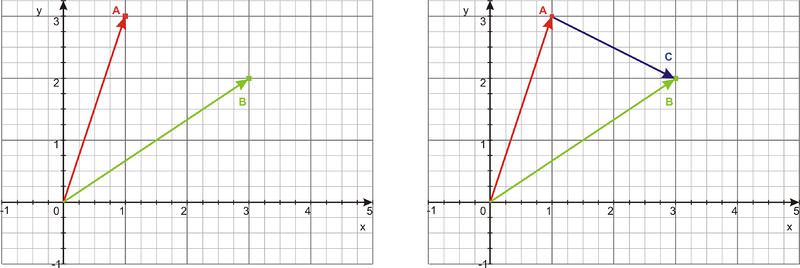
Vector to a Point Between Two Points
Computer graphics artists frequently need to know the location of a point which lies midway between two other points. Once we know the position vectors for two discrete points, we can determine the midpoint between them using their coordinates. Specifically, the midpoint between points A and B is the “average” of the two positions, therefore the coordinates of the midpoint are given by \(\ x_{m p}=\frac{1}{2}\left(x_{A}+x_{B}\right),\ y_{m p}=\frac{1}{2}\left(y_{A}+y_{B}\right)\) and \(\ z_{m p}=\frac{1}{2}\left(z_{A}+z_{B}\right)\) and the position vector for the midpoint can be written as \(\ P_{m p}=\left\langle x_{m p}, y_{m p}, z_{m p}\right\rangle\). The vector from any other point to this midpoint can then be calculated using the method described in our discussion of displacement vectors.
" frameborder="0" height="450px" name="92185" src="https://www.ck12.org/flx/show/video/...rmula-Overview" thumbnailurl="" title="VideoObject?hash=f261914a433f4b13bcc48ed403f01e96" uploaddate="2016-07-07 20:43:28" width="85%">
Examples
Earlier, you were given a problem about finding the center of text on a sheet of graph paper.
Solution
If she knows that the first letter starts 10 boxes up and 5 boxes over from the bottom-left corner of the page, and the last letter ends 12 boxes up and 32 boxes over from the same corner, how could she find the center?
This is a midpoint question, so the x coordinate calculation is:
\(\ x_{m p}=\frac{1}{2}\left(x_{A}+x_{B}\right)=\frac{1}{2}(5+32)=18.5\)
and the y-coordinate of the midpoint is given by: \(\ y_{m p}=\frac{1}{2}\left(y_{A}+y_{B}\right)=\frac{1}{2}(10+12)=11\)
The coordinate of the center is: 18.5, 11.
The motion of an object along an inclined plane is a very common problem in introductory physics. The diagram below shows one such situation.
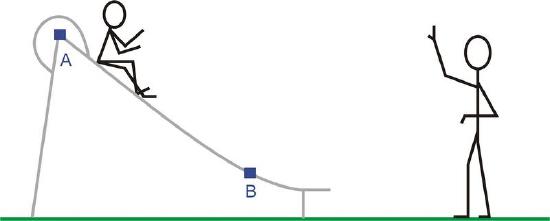
Stickman Beauford has taken his niece Brynna to the park and waves to her as she plays on the slide. Choose two coordinate systems that could be used to describe Brynna’s motion and identify the position vectors for points A and B in both coordinate systems.
Solution
If we want to describe Brynna’s motion as she moves from point A to point B along the slide, we could use a standard horizontal and vertical coordinate system with the origin at the base of the slide’s ladder, but then the vector describing her motion would have components in both the x and y directions. Our mathematical description of her motion can be greatly simplified if we choose point A to be the origin and if we rotate the coordinate system such that the x-axis is parallel to the slide and the y-axis is perpendicular to the slide. Now Brynna’s motion from point A to point B is only along the x-axis. Note, other choices of origin are possible.

Once we have identified an origin and coordinate axes for of our reference frames, we can use vector notation to identify the location of points A and B. The position vector for point A is the vector starting at the origin and ending at point A, \(\ \overrightarrow{O A}\). For the standard coordinate system shown on the left above, the position vectors \(\ \overrightarrow{O A}\) and \(\ \overrightarrow{O B}\) are shown on the left below. For the rotated coordinate system, shown on the right above, the position vector \(\ \overrightarrow{O A}=0\) and \(\ \overrightarrow{O B}=\overrightarrow{A B}\).

Determine the coordinates and magnitude of the vector, D, beginning at the point \(\ \overrightarrow{P_{1}}=\langle 12,7\rangle\) and ending at \(\ \overrightarrow{P_{2}}=\langle 8,10\rangle\).
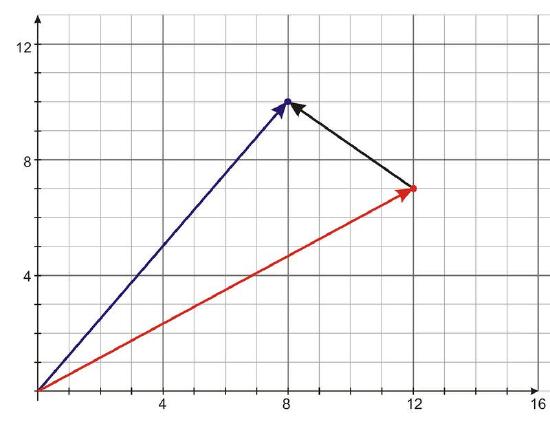
Solution
The displacement vector D is the difference between the two position vectors:.
\(\ D=\left\langle P_{2 x}-P_{1 x}, P_{2 y}-P_{1 y}\right\rangle=\langle 8-12,10-7\rangle=\langle-4,3\rangle\).
The magnitude of the vector, D, can be found using the Pythagorean theorem:
\(\ |\vec{D}|=\sqrt{(-4)^{2}+(3)^{2}}=\sqrt{25}=5\)
Determine the position vector identifying the midpoint between points \(\ \overrightarrow{P_{1}}=\langle 12,7\rangle\) and \(\ \overrightarrow{P_{2}}=\langle 8,10\rangle\).
Solution
Since these two points are located in the x-y plane, the x-coordinate of the midpoint is given by
\(\ x_{m p}=\frac{1}{2}\left(x_{A}+x_{B}\right)=\frac{1}{2}(12+8)=10\)
and the y-coordinate of the midpoint is given by
\(\ y_{m p}=\frac{1}{2}\left(y_{A}+y_{B}\right)=\frac{1}{2}(7+10)=8.5\)
Therefore the position vector for this midpoint can be written as
\(\ P_{m p}=\langle 10,8.5\rangle\)
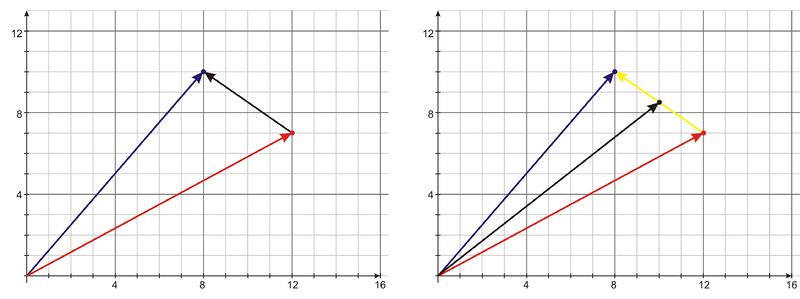
Identify the position vectors for the three points shown on the grid below.
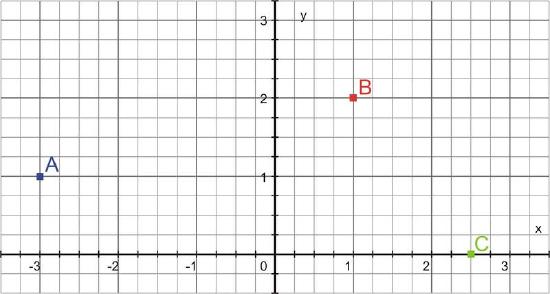
Solution
The position vectors begin at the origin, (0, 0) and end at each point:
\(\ \overrightarrow{O A}=\langle-3,1\rangle, \overrightarrow{O B}=\langle 1,2\rangle \text { and: } \overrightarrow{O C}=\langle 2.5,0\rangle\)
The diagram shows two positions of a bicycle as it moves along a long straight road. Two possible coordinate systems for the motion are shown below. Determine the position vectors in each of the two coordinate systems for the bicycle at points A and B. Then determine the displacement vector from A to B in each case. (Not drawn to scale.)

Solution
The diagram shows two positions of a bicycle as it moves along a long straight road. Two possible coordinate systems for the motion are shown below. Determine the position vectors in each of the two coordinate systems for the bicycle at points A and B. Then determine the displacement vector from A to B in each case.
For the upper coordinate system, the position vector of the bicycle at point A is given by \(\ \overrightarrow{r_{A}}=\langle-300 m, 0,0\rangle\) and that at point B is given by \(\ \overrightarrow{r_{B}}=\langle 100 m, 0,0\rangle\). This gives a displacement of \(\ \overrightarrow{\triangle r_{A-B}}=\langle(100 m-(-300 m)),(0-0),(0-0)\rangle=\langle 400 m, 0,0\rangle\).
For the upper coordinate system, the position vector of the bicycle at point A is given by \(\ \overrightarrow{r_{A}}=\langle 100 m, 0,0\rangle\) and that at point B is given by \(\ \overrightarrow{r_{B}}=\langle 500 m, 0,0\rangle\). This gives a displacement of \(\ \overrightarrow{\triangle r_{A-B}}=\langle(500 m-100 m),(0-0),(0-0)\rangle=\langle 400 m, 0,0\rangle\).
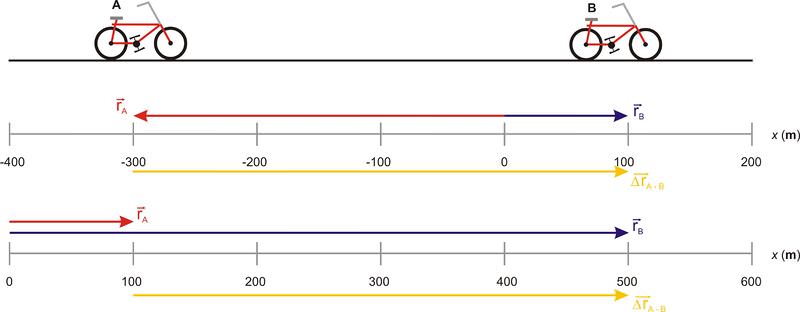
The position vectors for the bicycle at point A are shown in red and the position vectors for point B are shown in blue. The displacement vector between points A and B is shown in gold. As you can see, the position vectors representing this motion depend on the choice of coordinate system, but the displacement vector is independent of the coordinate system. No matter how we define the origin, the bike moves 400 m in the +x direction and does not move in the y or z direction.
Identify the position vectors for the three points shown in the diagram below.
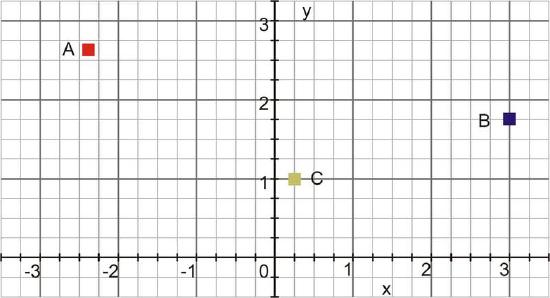
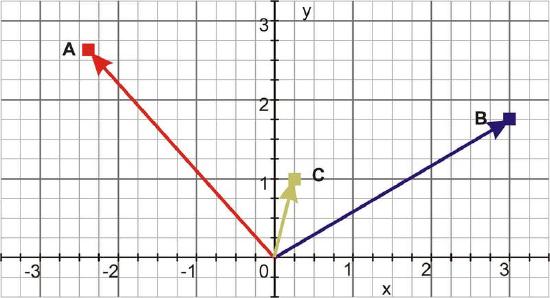
Solution
\(\ \overrightarrow{r_{A}}=\langle-2.63,2.63,0\rangle, \overrightarrow{r_{B}}=\langle 3,1.75,0\rangle, \overrightarrow{r_{C}}=\langle 0.25,1,0\rangle\)
Review
- What is a displacement vector used for?
Determine the coordinates and magnitude of the displacement vector, D, beginning at the point \(\ \overrightarrow{P_{1}}\) and ending at \(\ \overrightarrow{P_{2}}\).
- \(\ overrightarrow{P_{1}}=\langle 25,3\rangle\) and ending at \(\ \overrightarrow{P_{2}}=\langle 8,11\rangle\)
- \(\ \overrightarrow{P_{1}}=\langle 5,3\rangle\) and ending at \(\ \overrightarrow{P_{2}}=\langle 7,9\rangle\)
- \(\ \overrightarrow{P_{1}}=\langle 21,18\rangle\) and ending at \(\ \overrightarrow{P_{2}}=\langle 4,15\rangle\)
- \(\ \overrightarrow{P_{1}}=\langle 8,5\rangle\) and ending at \(\ \overrightarrow{P_{2}}=\langle 5,8\rangle\)
- \(\ \overrightarrow{P_{1}}=\langle 16,25\rangle\) and ending at \(\ \overrightarrow{P_{2}}=\langle 9,11\rangle\)
- \(\ \overrightarrow{P_{1}}=\langle 14,3\rangle\) and ending at \(\ \overrightarrow{P_{2}}=\langle 23,20\rangle\)
- \(\ \overrightarrow{P_{1}}=\langle 11,4\rangle\) and ending at \(\ \overrightarrow{P_{2}}=\langle 15,11\rangle\)
- \(\ \overrightarrow{P_{1}}=\langle 23,13\rangle\) and ending at \(\ \overrightarrow{P_{2}}=\langle 1,17\rangle\)
Determine the position vector identifying the midpoint between points \(\ \overrightarrow{P_{1}}\) and \(\ \overrightarrow{P_{2}}\)
- \(\ \overrightarrow{P_{1}}=\langle 17,6\rangle\) and \(\ \overrightarrow{P_{2}}=\langle 18,12\rangle\)
- \(\ \overrightarrow{P_{1}}=\langle 2,5\rangle\) and \(\ \overrightarrow{P_{2}}=\langle 1,9\rangle\)
- \(\ \overrightarrow{P_{1}}=\langle 24,7\rangle\) and \(\ \overrightarrow{P_{2}}=\langle 21,10\rangle\)
- \(\ \overrightarrow{P_{1}}=\langle 12,9\rangle\) and \(\ \overrightarrow{P_{2}}=\langle 2,20\rangle\)
- \(\ \overrightarrow{P_{1}}=\langle 15,17\rangle\) and \(\ \overrightarrow{P_{2}}=\langle 18,1\rangle\)
- \(\ \overrightarrow{P_{1}}=\langle 22,14\rangle\) and \(\ \overrightarrow{P_{2}}=\langle 23,8\rangle\)
- \(\ \overrightarrow{P_{1}}=\langle 1,7\rangle\) and \(\ \overrightarrow{P_{2}}=\langle 14,21\rangle\)
- \(\ \overrightarrow{P_{1}}=\langle 3,9\rangle\) and \(\ \overrightarrow{P_{2}}=\langle 8,1\rangle\)
Vocabulary
| Term | Definition |
|---|---|
| Displacement vector | A displacement vector models the movement between one point and another on a coordinate plane. |
| midpoint | The midpoint of two vectors is the location in the center of their endpoints. |
| position vector | A position vector describes the straight-line travel between a starting point (usually the origin) and the location of a second point on a coordinate plane. |

